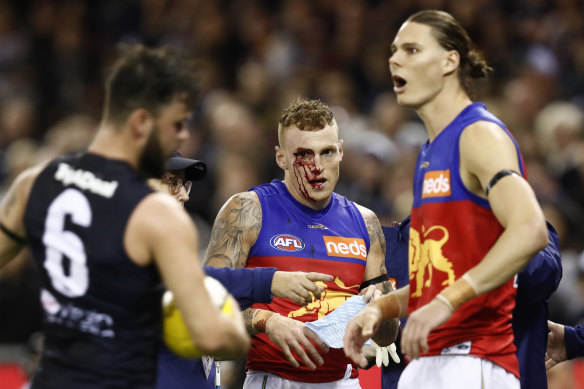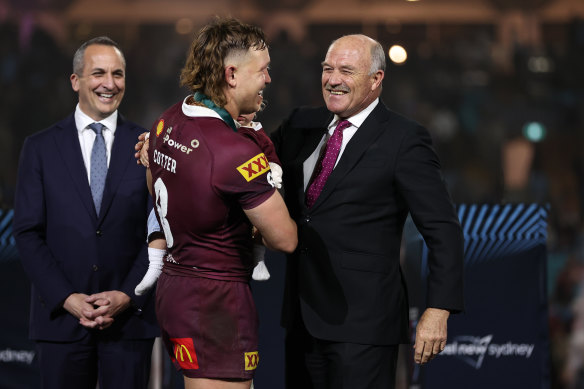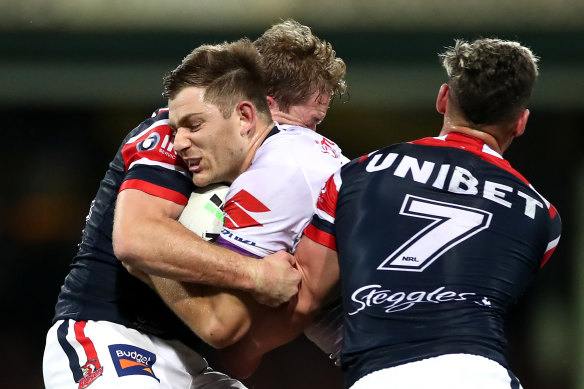This was published 1 year ago
‘We owe it to our kids’: The $18m fight from sports paddock to parliament
By Nick Wright
Mitch Robinson never seemed to care much for self-preservation when he took to the field. Not until he was a father, anyway.
The former Brisbane Lions star estimates he suffered “eight or nine” concussions in his 247-game AFL career, playing with the sort of head-on approach that garnered acclaim for his bravery, but fears over what it might cost him.

Mitch Robinson became renowned in his AFL career for his hard and fearless approach to a contest.Credit: Getty
“My style was to lead with the head and if I got knocked out it was a badge of honour,” Robinson told this masthead.
“Then I started having kids and figuring out CTE is a real thing, and you get nervous.”
The 34-year-old admits he knew what he signed up for when he chose such a path, even stepping into the boxing ring for the first time this month, fighting – and defeating – former Richmond forward Kayne Pettifer in Adelaide.
But he says the time has come to instil education and support systems throughout contact sport.
Those concerns have fuelled rugby league legend Wally Lewis’ latest fight, as he joined forces with recently retired Collingwood Magpies’ premiership-winner Nathan Murphy to address the National Press Club.
The pair have called for $18 million in funding towards chronic traumatic encephalopathy awareness and support programs.
Paul Green, Shane Tuck and Danny Frawley are among Australia’s elite sportspeople who have passed away with the deteriorating brain condition, associated with repeated head injuries.
Lewis, whose battles with dementia were revealed last year, pleaded for funding over three years to support the demands – including education programs in schools.
“Imagine a life where the tapestry of memories that define your very essence begins to unravel,” Lewis said.
“The threads of names, faces and cherished moments slip away, leaving behind a canvas of uncertainty. I am living with the constant fear and anxiety that I’ll let people down – this is my reality and the reality for all those living with dementia.
“One thing we do know is that CTE is the only form of dementia that is preventable, and we only get one brain.

Lewis, pictured at right celebrating Queensland’s 2023 Origin win, has revealed he is battling dementia.Credit: Brendon Thorne/Getty Images
“My call is for the Australian government to back this cause and provide federal funding for these two initiatives that will start the change and will provide hope for the future. We owe it to our kids.”
After his professional days came to an end, Robinson competed at local levels – including a stint for Morningside in the Queensland league.
Without the scrutiny and medical support afforded to players in the AFL, he appreciates several instances of concussion would have gone unnoticed.
Change is sweeping through the AFL, with mandatory 21-day stand down policies now in place across community levels.
But the reality, Robinson says, is that concussions are going to occur – and the best course of action would be ensuring that when they do, support is in place to identify them, and that athletes receive care and can recover.
“It’s a really touchy subject.
“There’s always an opportunity for players not to play, and it’s bound to happen in a contact sport, so you can’t fault the code that’s running the game. It’s more so the people behind the scenes who can give access to players post-retirement.
“Some players can get concussion without realising and not be seen by the doctors because they don’t have the footage of how they hit the ground, the warning signs, but most players are conscious about that.
“If it’s a big game, that’s when players don’t think about welfare, but it’s pretty hard to have a club doctor at every competition and club in the season.
“If they had the funding that would be great, but you have to be realistic.”
Sporting codes have sought to improve safety, with rule changes and harsher punishments for contact that threatens an athlete’s welfare.
Where in rugby league late tackles off the ball and high shots are scrutinised and typically lead to lengthy suspensions, rugby union has introduced guidelines across all levels of the game.
World Rugby is trialling a tackle height of the sternum and below in community levels, with suggestions it could be implemented in the professional ranks.
Former NRL halfback Ryley Jacks believes greater scope needs to be put in place at the lower levels.
Jacks forged a 48-game career with the Melbourne Storm and Gold Coast Titans, before joining Brisbane Tigers in the Queensland Cup.
“Being a halfback, I got hit late off the ball a lot, that’s what led to my two concussions.
“That wouldn’t happen to me [now], so I obviously feel a lot safer that the rules are protecting me a lot more, and also the protocols that go with it,” Jacks says.

Ryley Jacks pictured during his time with the Melbourne Storm.Credit: Getty Images
“But obviously, we train three nights a week and don’t have access to the doctors and physios NRL players do.
“We definitely do follow the same protocols, but in terms of the time we get from doctors and physios it’s very low.
“We get that, we’re semi-professional … but it is hard when everyone is working during the day, you’re having to tick these protocols off, whereas in the NRL they’re getting all this treatment, they’re in there every day.
“I think it’s a thing we definitely have to look at ... and we have, we’ve made great progress in the game, and I think it will continue going forward.”